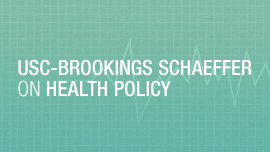This analysis is part of the USC-Brookings Schaeffer Initiative for Health Policy, which is a partnership between Economic Studies at Brookings and the University of Southern California Schaeffer Center for Health Policy & Economics. The Initiative aims to inform the national health care debate with rigorous, evidence-based analysis leading to practical recommendations using the collaborative strengths of USC and Brookings. We gratefully acknowledge financial support from The Commonwealth Fund.
Introduction and background
The health care sector has become increasingly vertically integrated in recent years. The initial waves of integration largely involved mergers and acquisitions between hospitals and physician practices. More recently, the parent companies of large health insurers have been acquiring pharmacy benefit managers (PBMs), specialty pharmacies, physician practices, and other related health care businesses.
In 2015, the three largest PBMs in the country (Express Scripts, CVS Caremark, and OptumRx) managed the drug benefits of 78% of the population. Following the Cigna acquisition of Express Scripts and the CVS/Aetna merger in late 2018, each of these PBMs is now part of a large health insurance parent company. (OptumRx is a UnitedHealthcare subsidiary.) Humana also owns and operates a large national PBM known as Humana Pharmacy Solutions.
In the provider market, UnitedHealthcare was estimated to employ about 50,000 physicians in the U.S. at the start of 2021 through its subsidiary OptumHealth. Cigna, CVS/Aetna, and Elevance Health (formerly Anthem), among others, are following suit. Specific examples include Cigna purchasing MDLive, Elevance Health purchasing the CareMore Health Group, and Humana purchasing the Metropolitan Health Networks physician group. Insurers are also acquiring home health agencies, ambulance providers, and data management firms. This is exemplified by Aetna purchasing the Healthagen health data company and Humana’s acquisition of home health company One Homecare Solutions.
Medicare Advantage (MA) plans are no exception to the broader trend toward greater vertical integration. Table 1 reports spending directed to related businesses by health plans owned by parent companies that together accounted for about 65% of MA enrollment in 2022. Note that for several companies (e.g., UnitedHealthcare, CVS/Aetna), there has been marked growth in the share of spending accounted for by related businesses overall. The reported share of spending on related businesses for UnitedHealthcare grew nearly 250% from 2016 to 2019. Likewise, the related business share rose over 5-fold for CVS/Aetna during the same time period, likely due to their merger that was closed in November 2018. In addition, for Kaiser the related business share of spending has been over 60% for some time.
Data for future years will likely show substantial additional increases in the role of related businesses. The data examined in Table 1 do not appear to reflect the effect of Cigna’s acquisition of Express Scripts in late 2018, nor Elevance Health’s launch of its own PBM, IngenioRx, in 2019. Moreover, there has been significant merger and acquisition activity taking place in this sector since 2019.

Vertical integration has a range of potential consequences for the health care sector, both positive and negative. In this paper, we specifically examine how MA plans’ ownership of related businesses may affect MA plans’ spending patterns and the implications for regulation of those plans.
Vertical integration could either increase or decrease MA plan spending. On the one hand, obtaining certain types of goods and services through related business could improve MA plans’ efficiency and thereby reduce their spending by eliminating “double marginalization” or improving care coordination.[1]
However, as we have noted in a prior analysis, vertical integration may weaken regulations aimed at reducing the potential for “overpayment” of MA plans. One important such regulation is the rule governing MA plans’ Medical Loss Ratio (MLR), the ratio of plan spending on health care claims to its premium revenues. The Affordable Care Act required MA plans to maintain an MLR of at least 85% in an effort to improve alignment of “costs” and payments. If a plan repeatedly uses less than 85% of premium revenues for health expenses (as opposed to administrative costs or profits), then it could be subject to sanctions. However, plan spending directed to related businesses (such as physician groups and PBMs owned by the parent company) is treated as a cost and counted as claims spending when calculating the MLR, even if some of that spending represents profits for the parent company.
The MLR rules thus give rise to two types of incentives that could cause vertical integration to raise actual or reported MA claims spending. First, related businesses not subject to MLR rules may set the “transfer prices” used to value transactions with MA plans in the same parent company above market-level prices as a means of relaxing the constraint on profits posed by MLR rules. This behavior would increase reported claims spending, although it could reduce actual claims spending if it substituted for other strategies plans had used to meet the MLR requirement that increase claims spending. Second, parent companies may direct their MA plans to purchase goods and services from related businesses to take advantage of this opportunity to circumvent the MLR rules. Shifting spurred solely by efforts to evade MLR rules would likely reduce efficiency and thus increase plans’ spending.
Analytic plan
The aim of this analysis is to provide some empirical clues to advance the understanding of related businesses and their impact on MA plan performance. Developing a direct understanding of how related businesses affect financial processes in MA plans would require obtaining information on transfer prices used within each parent organization. Transfer prices among related parties for multi-entity health care enterprises are typically not publicly available. Therefore, our analytical strategy is to obtain indirect empirical clues by examining the spending impacts associated with expanded use of related businesses. We develop indirect evidence by examining risk adjusted health spending per enrollee for MA plans.
As discussed earlier, the vertical integration of MA plans and related service providers such as PBMs, physician practices, and home health agencies can alter incentives in a fashion that increases efficiency and thereby lowers claims spending, or it can be used to circumvent payment regulations, potentially raising (reported) claims spending. We therefore examine the association between MA plan spending levels and the extent of reliance on related businesses by health plans. A negative relationship between related business spending and MA risk adjusted spending per enrollee offers a clue consistent with efficiency gains that may arise from elimination of double marginalization or improved care coordination. In contrast, a positive association between reliance on related businesses and risk adjusted per enrollee spending is consistent with the use of transfer prices that are set to circumvent MLR payment regulation.
We highlight that our results will yield an association, not a causal estimate, because our largely cross-sectional analysis relies on estimating differences in outcomes across organizations that differ with respect to their ownership of related businesses but may also differ in ways that we cannot measure and control for. While we include controls for the parent company and various other observable plan characteristics, there is still a risk that unobserved differences between plans may drive the relationship we estimate between related business spending and claims spending.
Data
Our analysis combines data from several sources to estimate the association between related business spending by health plans and risk adjusted medical expenditures by MA plans. Our main data source to identify related business spending and medical expenditures by plan/year comes from the Mark Farrah (MF) Health Coverage Portal. The National Association of Insurance Commissioners (NAIC) compiles certain financial information reported to state insurance commissioners by health plans on an annual basis, and includes a supplemental exhibit called the Summary of Transactions with Providers. This exhibit breaks out medical expenditures made to affiliated and unaffiliated parties across all business segments of a given plan (i.e., Medicare, Medicaid, Individual Commercial, Group Commercial, etc.). This accounting of transactions with affiliated and unaffiliated providers is used as a proxy for related business spending as a share of total medical spending.
Data on the financial performance of a plan including our estimates of medical expenditures come from the Operations by Line of Business exhibit within the MF data. This reports all revenues and costs for a given plan/year and allows for more granular analysis of spending per member. To account for health status differences between the enrollees of different plans, we link Centers for Medicare & Medicaid Services (CMS) Risk Score files to the MF data. The CMS Risk Scores are constructed at the contract/benefit package/year level, so we take the enrollment-weighted average score aggregated to the plan/year level using CMS MA enrollment files. It is important to recognize that vertical integration can directly affect the risk score because the greater integration of clinical providers (e.g., physicians) with health plan services can facilitate coordination of clinical reporting with health plan financial interests.
To examine the association between related business spending and risk adjusted medical expenditures, we estimate a series of regressions that attempt to control for observable determinants of plan performance. Specifically, the models we estimate control for the state in which a plan has its maximum enrollment, the parent company sponsoring the plan, the size of the plan measured by MA enrollment, and year. Because our key independent variable, the related business share of medical expenditures, captures payments to related parties across all lines of business, we also control for the share of total plan enrollment accounted for by MA enrollment, which we obtain from the Enrollment by Segment exhibit in the MF data. This is to account for the fact that as the share of enrollment accounted for by MA increases, marginal increases in related business expenditures across all business segments will impact MA-specific risk adjusted health expenditures more.
We estimated several model specifications of the related business share of plan spending and change in MA medical expenditures per enrollee in a plan/year. We varied the specification by using: 1) either the contemporaneous related business share or the one-year lagged measure of the related business share as the independent variable, 2) the raw health cost per member with a control for plan risk score or the risk adjusted health cost per member, and 3) log and linear specifications for our dependent variables. This gives us eight total models that span the full combination of these three sets of specifications. In the discussion that follows, we focus on linear specifications of the dependent variable with same-year related business spending as the explanatory variable. (We also report complete model results in Table 4).
Note that for all results reported below, we exclude plans that report negative or zero premiums or claims, have an annual MA enrollment below 1,000 members, or are not domiciled in the 50 states or Washington, D.C. The exhibits from MF used for the subsequent calculations comprise MA plans sponsored by all registered health insurers with the NAIC, excluding California HMOs. MA plans sponsored by insurers registering as life insurance entities are not required to file the exhibits used in the analysis and are thus excluded from subsequent calculations.
Results
Descriptive findings: Table 2 reports spending per enrollee in the MA program for the years 2016 through 2019, the percentage of MA plans that are parts of multi-entity organizations where health plans purchase the services of related businesses, and the share of enrollees that are served by MA plans that are parts of multi-entity organizations where services (for all payers) are purchased from related entities.[3] The risk adjusted spending per enrollee normalizes each plan’s risk score to 1.0, equalizing for reported changes in enrollee health status across plans. Conceptually, this is meant to correspond to what MA plans would have spent on a traditional Medicare (TM) enrollee, on average. There is considerable evidence, however, that reported risk scores in MA overstate the actual claims risk of MA enrollees, in which case our risk adjusted estimates will understate what TM would spend on a comparable enrollee. Our adjustments may nevertheless help us ensure that differences in claims risk across plans do not generate spurious relationships between the related business share and spending.
The results in the table show that most MA plans are part of parent companies that own related businesses. Comparing rows three and four of Table 2 suggests that the plans associated with parent companies that own related businesses are larger than those that do not, since the share in row four exceeds that reported in row three. Gross spending per enrollee grew 11.0% from 2016 to 2019. Risk adjusted spending grew by a little more than half that rate, 6.9%.

Table 3 reports spending per enrollee for MA plans that have purchases from related businesses that account for more than 10% or less than 10% of expenditures (including zero purchases). We also report the MLR level for plans with related business purchases above or below the 10% threshold. The data in Table 3 indicates that plans with a higher percentage of their costs being accounted for by related businesses have higher gross and risk adjusted spending, on average. Plans with over 10% of spending going to related businesses have gross health expenditures per MA enrollee that were 4.6% higher than those with less than 10% related business spending shares in 2019. The risk adjusted spending per enrollee was 2.4% higher for the plans associated with larger related business spending shares.
We also examined differences for plans with more or less than 25% of spending accounted for by related businesses. Those results (reported in the appendix) showed somewhat larger spending differentials per MA enrollee. Finally, the MLRs for the plans associated with parent companies with high shares of related business spending were generally lower than those with less spending on related businesses. This may reflect the larger set of mechanisms for managing how expenditures are incurred and reported that are at the disposal of vertically integrated plans.
 Statistical model results:
Statistical model results:
Table 4 reports estimates of the association between the share of related business expenditures and per enrollee medical expenditures. Those estimates show that the association is generally significant at conventional levels (p < 0.05) in specifications using the linear formulation. For all models except the association between contemporaneous related business share and risk adjusted medical spending, the estimates are significant at p < 0.05.[4]

The magnitude of the estimates indicates that a 10 percentage-point change in the related business share of spending by the plan is associated with a $140.18 increase in raw spending per enrollee and a $105.23 increase in risk adjusted spending per enrollee. That corresponds to a 1.41% and a 1.15% increase in per-enrollee spending respectively.[5] Putting that figure into context, consider that in 2022 there were roughly 28 million people enrolled in MA. That means that an increase of 1.4% in health expenditures per enrollee would translate into roughly $3.9 billion in additional MA plan spending over the existing base level of spending.
While these additional payments received by the related entities represent costs for the purposes of the MLR calculation, they also can represent significant profits to the parent company. Take for example the case of PBMs. As mentioned previously, many of the largest MA plan sponsors are part of parent companies that also own and operate large PBMs (e.g., UnitedHealthcare, CVS/Aetna, Cigna, Humana, and Elevance Health). According to GAO, PBMs accounted for 74% of drug benefit management services through Part D as of 2016. The largest PBMs were reported to have margins ranging from 4% to 7% in 2017, which were considered to be a potential undercount. Thus, owning a related entity such as a PBM can create tens if not hundreds of millions of dollars in profits not subject to the MLR.
Though our estimates suggest a 10-percentage point increase in the related business share of spending would decrease the average profit per enrollee by roughly 40% (from $339 per member to $199 per member), this says nothing about the potential impact on the profits of the parent company. As discussed above, the increased health cost spending reduces profits from MA business, but transactions with related parties can still represent profits to the parent company, especially if higher transfer prices allow the plans to evade the MLR regulations.
The estimated impact of related businesses on raw spending has a direct effect on the calculated MLR. The estimated 1.4% increase in health expenditures associated with a 10-percentage point increase in the related business share of parent firm spending translates into a change in the MLR of 1.3 points when evaluated at the mean of the sampled plans.[6] As reported in Table 3, the average MLR was within this margin for plans with more than 10% of expenditures going to related businesses in 2019. This implies that increases in related business spending have the potential to move health plans from the region where they would be subject to penalties to where they would meet the MLR standard.
Lessons for further examination
The analysis presented here offers indirect clues about one consequence of vertical integration that involves MA plans and their parent companies. Because transfer prices are not observable (since they are not publicly reported) and our analysis is largely cross-sectional in nature, our analysis can only provide empirical clues, not a direct causal analysis. But our estimates, derived from a large sample of plans and with a robust set of controls, provide evidence that related business spending is associated with higher health expenditures by a statistically significant margin. This is consistent with concerns that vertical integration by MA plans may allow for evasion of MLR regulations.
The broader literature on the impacts of hospital-insurer integration is mixed, with analyses finding welfare reductions and increases in different empirical contexts. Our analysis focuses specifically on the regulatory context of the MA program. We argue that the presence of MLR regulations and the potential for penalties if health expenditures drop sufficiently far has the potential to create distortionary incentives for vertically integrated MA plans.
These results support the idea that MLR regulations in the absence of transfer price regulations may result in conduct that circumvents the intent of the MLR policy. Yet because our evidence is indirect, incomplete, and potentially subject to various statistical biases, further investigation is necessary to supplement our work. Ideally, CMS would obtain detailed information on transfer prices and internal financial processes through audits and information requests. Such information gathering and regulation would not be unusual. Transfer prices are monitored by the Internal Revenue Service to ensure consistency with pricing practices between unaffiliated entities. This would enable analyses that could identify whether transfer prices were being set in ways that weaken MLR regulations, and potentially pave the way to a regulatory response if necessary.
The Brookings Institution is financed through the support of a diverse array of foundations, corporations, governments, individuals, as well as an endowment. A list of donors can be found in our annual reports published online here. The findings, interpretations, and conclusions in this report are solely those of its author(s) and are not influenced by any donation.
Footnotes:
[1] Double marginalization occurs when two firms with market power, at different parts of the supply chain, both mark-up their prices. This leads to relatively higher prices compared to when the same two firms were to merge, since the downstream firm no longer has an incentive to mark-up its price.
[2] Note that there is a well-developed literature on the efficiency incentives created by MLR regulations (for example, see Cicala et al., 2019). Our analysis is focused on a second type of incentives that stems from the interaction of MLR regulations and the organizational structure of health care companies.
[3] Throughout the analysis, spending and risk adjusted spending per enrollee includes Part D spending, where applicable.
[4] To account for the aforementioned concern that risk score coding may be directly impacted by the level of integration within a parent company, we ran a sensitivity analysis that uses raw health cost per member as the dependent variable with no control for the plan’s risk score. These models yield very similar results, with the linear models having coefficients of 16.289 (p = 0.06) and 13.177 (p = 0.02) for current and lagged RB spending, respectively. The log-linear models each have coefficients of 0.001 (p < 0.10), also in line with our other estimates.
[5] The estimated association for the models where the natural log of spending is the dependent variable are somewhat smaller, on the order of 0.8% for a 10-percentage point increase in the related business share of spending. More details can be found in Table 4.
[6] Note that our estimated enrollment weighted mean MLR based on the data from Mark Farrah is very close to the weighted mean MLR calculated by CMS for the same set of plans (89.351 in our data and 89.637 calculated using the CMS data).
Appendix

-
Acknowledgements and disclosures
The authors thank Gretchen Jacobson and Matthew Fiedler for their helpful comments on an earlier draft.
The Brookings Institution is committed to quality, independence, and impact.
We are supported by a diverse array of funders. In line with our values and policies, each Brookings publication represents the sole views of its author(s).






Commentary
Medicare Advantage spending, medical loss ratios, and related businesses: An initial investigation
March 24, 2023